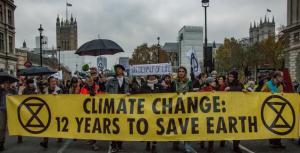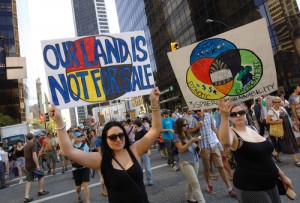“The earth is not dying, it is being killed, and those who are killing it have names and addresses.”
— Utah Phillips
In the summer of 2003, my friends and I launched a campaign called Dirty South Earth First! (DSEF!) that targeted the executives of financial holding company MAXXAM in their ostensibly safe gated communities in suburban Houston. MAXXAM was the parent company of Pacific Lumber (PALCO) which spent decades logging the majestic Redwoods of Northern California.
MAXXAM’s CEO Charles Hurwitz bought PALCO and escalated the logging of Northern California for higher profit and the need to pay off the debt from the acquisition. Hurwitiz had a history of financial misdeeds including the raiding of worker pensions from other companies he’d bought and crashing a Savings and Loans costing U.S. tax-payers $1.6 billion during the financial crisis of the late 1980s.
Forest defenders in Northern California fought long and hard at the point of destruction in the lush forests of Northern California with tree-sits and road blockades. These fights against MAXXAM and Pacific Lumber had a long and sorted history. They included “Redwood Summer,” a mass direct action campaign organized by Judy Bari, which led to a pipe bomb being planted in Bari’s car in 1990, the death of forest defender David “Gypsy” Chain, who died when a tree was felled on him by loggers in 1998 and a yearlong tree-sit by celebrity Julia Butterfly Hill in 1999.
We humorously nicknamed the campaign “Dirt First! after a Simpsons’ episode where Lisa sits in a tree to save Springfield’s last Redwood, but took our campaign very serious as we had the lofty “No Compromise” goals of MAXXAM divesting from PALCO and ending clearcutting operations in Northern California.
The DSEF! campaign utilized a different strategy to pressure MAXXAM into stopping the devastation. It was modeled on the Stop Huntington Animal Cruelty (SHAC) campaign which included the targeting individual executives with “naming and shaming” tactics at their homes, their places of worship, their communities and in their personal lives. SHAC had been an effective animal rights campaign that bankrupted the world’s largest animal testing company, Huntington Life Sciences, a number of times as well as getting them delisted from the New York Stock Exchange. Eventually governments in Britain and the United States intervened with financial bailouts for Huntington, prosecuting SHAC organizers and sending them to federal prison.
That summer, our first wave of actions began with two very distinct tactics: a symbolic tree-sit in Memorial Park, a large urban Houston park near Hurwitz’s home led by North Coast Earth First!ers who’d been on the frontlines of resistance to PALCO’s logging; and home demonstrations and other “naming and shaming” tactics targeting MAXXAM’s top corporate officers. The tree-sit captured the attention of the local media while the personalized protests send shockwaves into MAXXAM’s corporate elite and their neighbors.
While the tree-sit ended by the end of the summer, the “SHAC-tics” against MAXXAM’s execs lasted for over a year. While other campaigns compromised with Pacific Lumber and other logging companies for a kindler gentler form of logging of Northern California’s Redwoods, we offered an uncompromising approach. DSEF! was not only ignored, shunned or denounced by more mainstream environmentalists (shocking, I know), but within Earth First! community as well. Our tactics left many uncomfortable in the forest defense movements.
As my DSEF! co-organizer scott crow has said “We weren’t being vanguardist, but just pushing the edge of where political action might go. The radical enviro movement had really lost its militancy and was comfortable in the forms of resistance like blockades and tree-sits. I’m not knocking those, but corporations and the state had adapted to them and expected them. When we stepped in, it was outside the EF! norm.”
Our goal for Dirty South Earth First! was to be a more widespread campaign that targeted companies doing business with our targets. That didn’t work. Our capacity and resources only allowed the campaign to be effective at local actions in Houston. DSEF! eventually burned out due to that lack of growth of a wider campaign. Furthermore, repression by the state played a role as well. We later learned that the Federal Bureau of Investigation (FBI) had an in the Houston activist community reporting on us regularly and MAXXAM had private security that monitored our activities.
Clearcutting in the Redwoods continued, but a number of MAXXAM executives ended up leaving the company or relocating to more secure gated communities (which we still protested). Not long after DSEF! folded, Pacific Lumber declared bankruptcy and relinquished the land, thus saving the last few remaining Redwoods. DSEF! played a small role in these turn of events, but the loss of forest, wilderness and biodiversity for corporate profit was beyond cost.
Moving forward over the past 12 years with the hard lessons of Dirty South Earth First!, I’ve been an active participant in the North American direct action movements against the extraction of oil, coal and natural gas with the explicit goal of supporting those on the frontlines of fossil fuel extraction and keeping all fossil fuels in the ground. The demand of “No Compromise” continues to evade mainstream environmental organizations who seek a redress of climate grievances in the corporate dominated political status quo.
The most recent (and biggest, to date) example of the failure of mainstream liberal and environmental compromise came during the 21st United Nations Conference of Parties (COP21) climate talks in Paris. The agreement, signed by nearly 200 nations, failed to address the most pressing issues facing the climate and global communities. It sent a powerful message that the governments of the world are committed to participating in the carbon emissions trading economy, not addressing a low-carbon future or keeping fossil fuels in the ground. The agreement states its goal is to limit temperature increases to 1.5 degrees, but shows no tangible mechanisms to deliver such a lofty goal. Furthermore, negotiators removed the rights of Indigenous people and reparations for those impacted by climate change in the Global South.
Hailed as a triumph by politicians such as French President Francois Hollande, UN General Secretary Ban Ki-moon and Barack Obama, the mainstream environmental non-profit complex followed suit: Sierra Club (“a turning point for humanity”), Environmental Defense (“a transformative moment”), Natural Resources Defense Council (“A great tide has turned”), and Avaaz (“Victory! The end of fossil fuels has begun…”). The environmental establishment continues to support the politicians that perpetuate notions of unrealistic action on climate change, climate injustice and social inequality.
In contrast, a broad spectrum of voices from the scientific community to frontline groups to grassroots direct action groups pronounced the agreement an epic failure. U.S. climatologist James Hanson called the agreement “bullshit” and added ‘we’ll have a 2C warming target and then try to do a little better every five years.’ It’s just worthless words.” UK climate scientist Kevin Anderson of Tyndall Centre for Climate Change Research called the agreement “weaker than Copenhagen” and inconsistent with current science. Noted British climate campaigner and policy expert George Monbiot said “by comparison to what it could have been, it’s a miracle. By comparison to what it should have been, it’s a disaster.”
The Climate Justice Alliance, a coalition of North American frontline and climate justice groups, called the Paris Agreement “a failure for humanity.” They further stated that market based mechanisms from “cap and trade in California, to the carbon trading requirements of the Clean Power Plan,” particularly in the United States and Canada, to offset catastrophic climate change is “blind to the stark realities of climate crisis.” Anti-capitalist climate justice group Rising Tide North America articulated that the agreement was “exploitive, deceitful and hollow, favoring the rights and voices of corporations over people.”
The marketplace had its own opinions about Paris. Wall Street banks joined the climate action early with investments in renewable energy and pledging to drop losing industries like coal mining, while still funding coal power plants and the oil and gas industries. Goldman Sachs got in line with the Obama-Big Green public relations strategy and called the outcome in Paris “the most ambitious climate deal since 1997.”
But, the oil industry saw some fallout from Paris. Exxon declared they expect to see a permanent decrease in its stock value after the agreement. West Texas crude prices dropped to $34 a barrel and are expected to dip as low as $20 a barrel. Also, Exxon also had a 37% drop in revenues this quarter from this same time in 2014.
But oil and gas trade associations don’t see it impeding long term oil and gas development. During COP21, the Obama administration signed legislation to allow the continuing expansion of infrastructure. The Exxon-Koch Industries backed FAST (Fixing America’s Surface Transportation) Act that permits the expediting of federal permits on oil and gas pipelines. This is at least partially in response to the “Keystone-ization” of fossil fuel projects by environmentalists and local communities. Furthermore, emails and documents obtained by reporter Steve Horn revealed that the U.S. International Trade Agency facilitated and promoted business deals for the Liquefied Natural Gas industry and export terminal owners before federal agencies had approved permits.
The coal industry took a harder line on the agreement when Brian Ricketts, the head of the European coal lobby, said that the Paris agreement would lead to the coal industry being vilified “like slave traders.” After the agreement, the world’s largest coal company Peabody Energy took at 12% stock hit and Consol Energy saw its stock fall 3%. In the United States, regulation, environmental campaigns, the proliferation of renewables and the price of gas have hurt the industry, but nations like Australia and Indonesia continue to export vast amounts of it. Furthermore, worldwide, the equivalent of over 350,000 megawatts in new coal power generation is under construction or approaching approval for construction. Like Yogi Berra said “it ain’t over until it’s over.”
Meanwhile, the planet continues to react to the emission of greenhouse gases by human activity with rapidly changing weather patterns and large scale natural disasters. At the end of December, the North Pole saw a 60 degree spike in temperatures making the region warmer than many cities in North America and Europe. In South American countries like Argentina, Brazil, Uruguay and Paraguay saw floods touched off by El Nino displace 150,000 people. In Southern Africa, 29 million people are expected to face critical food shortages due to drought. In the Middle East, temperatures spiked from Egypt to Syria. In Pakistan, the heatwaves took 2,000 lives and in India, 2,500. Arctic eco-systems are being impacted by a warming world with melting ice, endangered wildlife and impacted Indigenous communities.
Global levels of carbon in the atmosphere averaged around 400 parts per million (ppm) for the entire month of March 2015. The scientific community tells us that if not returned to at least 350 ppm than climate catastrophe will only continue to grow in scale and extremity. Nature doesn’t compromise in the same way as political systems. Or really at all.
As daunting as it sounds the gross agenda of industry, banks and compromised political and not for profit institutions can still be undercut and the worst impacts of the climate and environmental crisis mitigated. Most importantly, the poisoning and polluting of communities on the frontlines of environmental disaster can be stopped. Through history, we’ve seen movements for equality, justice and ecological sanity build power and take on the agenda of the corporations and the politicians that love them.
After Paris, Obama, the Democrats, the liberal environmental establishment and governments around the world will defend the Paris narrative that the COP21 agreement is an effective solution to climate change. But, our fight is far from over. There are tangible institutions responsible for fossil fuel extraction, infrastructure and combustion. As noted above, industry has learned the lessons of Keystone XL and begun to shift rules and regulations to make resistance more difficult. Furthermore, movements will encounter an increasingly unaccountable police and corporate surveillance state.
In the face of these new obstacles, our organizing must take the small disparate pieces of the existing climate movement and grow them exponentially to become a fierce, more militant, counterbalance to the industry.
Ongoing lessons when fighting for climate justice:
System Change: We can’t lose sight that each action and campaign is pushing us towards system change. The existing political economy is hardwired in anti-democratic and exploitive behavior. Stopping a pipeline, a coal company or ending the clearcutting of the Redwoods is not enough. We must continue to fight for greater system change. Fight corporations. Fight capitalism.
Revoking the social and political license of fossil fuels: We must utilize strategies that create an environment so toxic for the climate pollution industry, its executives, its politicians and the financial institutions that back them that business as usual becomes impossible. Enough said.
More militant tactics: In 2012, the Tar Sands Blockade held an 80 day tree-sit and organized dozens of actions disrupting construction on the Keystone XL pipeline costing oil company TransCanada millions of dollars. In Peru, social movements are fighting mining projects with militant street tactics and sabotage of machinery. This past weekend, Black Lives Matter Cleveland went to the home District Attorney Tim McGinty, who refused to indict police officers who’d killed 12 year old Tamir Rice, demanding his resignation. Tactics costing corporations, political institutions and the individuals that run them economic and social capital are effective. Be bold, be militant and escalate.
Harness Rebel Energy: Non-profits, Democratic politicians, groups with big mailing lists, socialist senators from Vermont and various other manifestations of the existing political system are not the movement. The momentum to stop climate change is going to come from the rebel energy that operates outside the current political system. Author and activist George Lakey penned in the pamphlet The Sword That Heals: “You can’t pull off powerful nonviolent direct action without rebel energy. You’ve run this campaign as a conventional lobbying operation and you can’t — at the last minute — switch gears and become a nonviolent protest movement!”
In many ways, Dirty South Earth First! is an important example for environmental radicals taking action on a villainous target with uncompromising goals. It gives a broader analysis of environmental destruction, corporate power and how to strategically move these bigger institutions.
It is very clear that people are hungry for action. The brushfire rebellion against fossil fuels continues to burn. Folks are organizing against oil pipelines, fracking, export terminals and coal every day across North America. The part to remember is that these campaigns require effective strategies and uncompromising goals. In the words of a previous generation on the streets of Paris: “Be realistic, demand the impossible.”
 resistance to fossil fuels, its financiers and the politicians that love them has hit new levels with the goal of meeting the scale of the climate crisis with equal amounts of people powered momentum. As a result, climate and anti-fossil fuels action, both large and small, has spread globally.
resistance to fossil fuels, its financiers and the politicians that love them has hit new levels with the goal of meeting the scale of the climate crisis with equal amounts of people powered momentum. As a result, climate and anti-fossil fuels action, both large and small, has spread globally.






